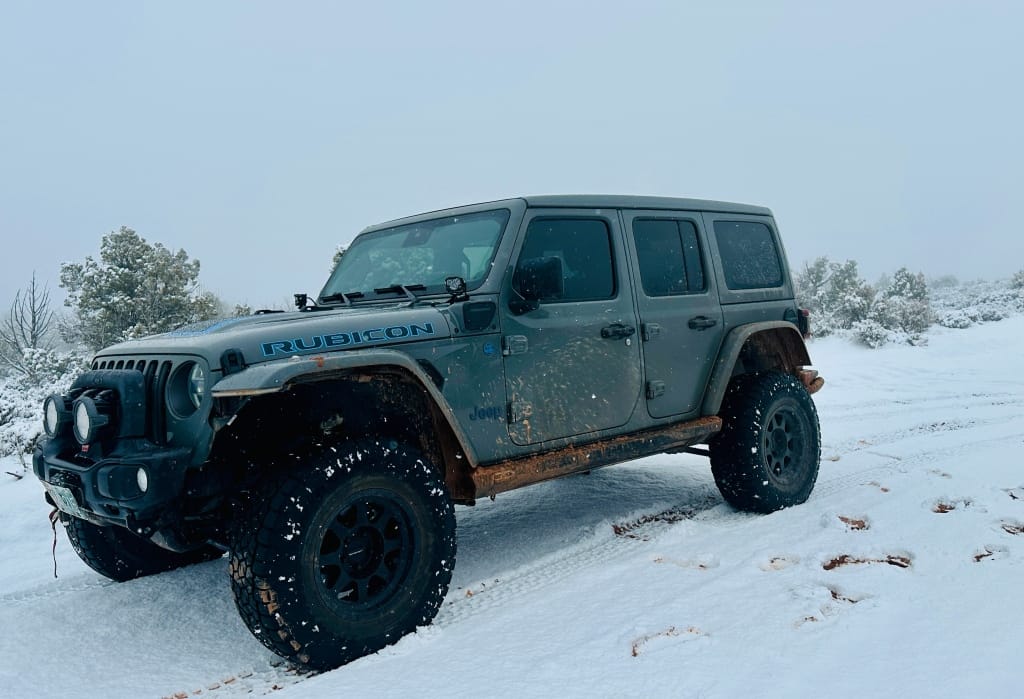What it's like to drive a plugin-hybrid for the past 6 months
Last year I bought the number one selling plugin-hybrid vehicle sold in America, and I even got a $7,500 tax rebate for the purchase. And before you try and guess, I'll say that nope it wasn't a Prius, it was a Jeep Wrangler Rubicon 4xe.

It's ridiculous that a 5,000lb tank with the aerodynamics of a brick would get electrified (or that anyone would get a rebate for this option), but it makes sense when you look at the whole Jeep Wrangler line-up. Their flagship V8 Wrangler only gets about 13-14mpg. Their V6 model gets about 18mpg. They make a small turbo 4 cylinder that gets around 20mpg. They used to sell a diesel model that got up to 30mpg on the highway, but canceled it this year probably due to EPA phaseout rules. And EPA rules are probably what spurred Jeep to try and electrify their classic Wrangler so it didn't drag down the average fuel economy for the whole brand's lineup.
Why a Jeep?
Last year I wanted to get into more hardcore off roading and decided that a Jeep Wrangler was going to be miles ahead of any other option. Despite its engineering feeling closer to its World War II origins than the latest and greatest EVs that feel closer to today's laptops, I knew the simple construction and straight axles and healthy aftermarket could let me build exactly what I needed, and it delivered.
The Wrangler 4xe is an amazing machine and last Winter I took it to Moab, Utah to push it to the limits and it rarely disappointed me.

Why go plugin hybrid?
Hybrids and plugin hybrids are admittedly a middle step between conventional gas engines and fully electric vehicles. My considering of a plugin hybrid Jeep was that electrification in a huge country like the USA is going to be a decades-long project. Even though I drove an EV over 1,500 miles a few months ago with ample charging support, going into remote places would be impossible for any EV in 2023.
Hybrids date back to the early 2000s here and they're still selling well. Plugin hybrids are newer, only available for about the last ten years, but fill an important gap. The gist of it is that you can drive around town where you live running errands on full electric power, recharge at home, but you also have a gas engine as your backup for longer road trips. It solves the EV range anxiety problem and tries to give you the best of both worlds of gas and electric.
For me, it works really great. I live about 4 miles out of a small town, and typically I run errands in my car once or twice a day, racking up about 10 miles per trip. In the first month I owned this Jeep, I drove something like 1,500 miles before I bought my second tank of fuel. I have a level 2 charger in my garage which tops up the tiny 17kWh battery in about an hour (most EVs have about 75-100kWh of battery). The battery gives me about 20 miles of pure electric driving, which I use constantly around town.
I just hit over 14,000 miles on the odometer. Over the past six months, I've driven about a third of all those miles on electric power, with the remainder on gasoline. It's tough to estimate the total average fuel economy of the Jeep, but I would guess my longterm average to be around 25mpg if you consider gas-only power to be about 18mpg and EV-only at 49 eMPG. Costs are also hard to estimate since I have a large solar panel setup at home where I charge that makes daytime recharges basically free.
What are road trips like in a plugin hybrid?
Long road trips are a different story, and I typically don't use the electric option on freeways since 20 miles depletes the battery quickly. For my trip to Utah, I drove in the gas-only optional mode using the battery as a reserve, like an emergency tank of gas, and got about 16-18mpg driving the thousand miles to Utah. Once there, charging infrastructure was scarce and I could only charge it up once a night at my hotel. I switched to the "hybrid" driving option on trails to get the full benefits of both the gas engine and electric motor together, and it was also cool/freaky to drive over rough terrain hearing nothing but small twigs crunching beneath the tires. Also, most off road trails are only 5-10 miles long (but they can take several hours), so the electric power was plenty for most days there.
The energy regeneration options are great for descents and downhills, and on a few off road trips I've done, I've seen my battery gain 5-10% of its power just going downhill, using the brake regen to slow the Jeep down and store all that power while also saving the brakes from wear and tear.
It wasn't just one big Utah trip either. I've driven the Jeep to Vancouver, BC (about 700 miles round trip) and to Monterey, CA (about 1700mi round trip), and it worked well on those trips too.
Why not go full EV?
Don't get me wrong, full electric vehicles are more efficient, faster, more powerful, easier to maintain, and more fun to drive. But a sprawling country like the US simply can't deliver high output power to its far off reaches. Jeep has been showing off a full EV off road concept for several years now and it looks great and would work great on trails but our energy infrastructure just isn't there yet. Plugin hybrids are definitely a stopgap measure that aim to give you some of the benefits of EVs while also letting you take a thousand mile road trip in a day.
After six months, I'm pretty happy with my Jeep Wrangler. It's by no means quiet or comfortable, but its ruggedness makes it bulletproof in harsh winters and on rough terrain. The plugin architecture does complicate the maintenance and the platform as a whole, but it's kind of nice that I basically get to drive it around town running errands day to day and it costs me almost nothing.
Until electrification gets further along in America, this is the best current middle-ground compromise option and I would recommend this or any other plugin hybrid (especially the new Prius Prime, which offers about 45mi of pure EV power) to anyone looking to get the best of both worlds.

Subscribe to our newsletter.
Be the first to know - subscribe today





